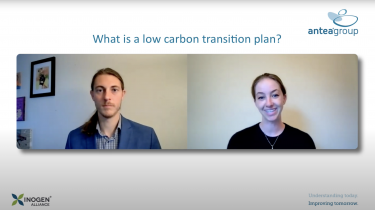A few of our experts from Antea Group USA were featured in an interview article with Environment + Energy Leader as seen here. The full transcript and video interview is below.
The negative impacts of climate change have been growing year after year. Whether it be a discrete event like the record-setting winter storm that engulfed Texas in February 2021 or a more chronic shift like the drought conditions that affected the western United States, the frequency and severity of these climate-related impacts are increasing. Historically, financial institutions have been able to diversify their portfolios to reduce their risk of exposure to climate change. However, given the systemic nature of these climate-related events, it may not be long before that approach becomes untenable.
Now is the time for companies to adapt their organizations to the risk of climate change. A low carbon transition plan can help. Learn more about the elements of a low carbon transition plan and where you can start from our Antea Group USA carbon services experts in the video below:

For those of you that would rather read, here is the transcript of the video:
Meet Charlie Quann:
Charlie: Hi, I'm Charlie Quann, I lead carbon services at Antea Group USA. I have a specialization in helping companies set science-based targets, and other carbon reduction goals, as well as defining the initiatives and strategies that they want to implement to achieve those goals. And that's sort of the focus of what we're going to talk about today, that low carbon transition plan, and what it means to a company.
Meet Allie Wiegel:
Allie: My name is Allie Wiegel. I'm a Project Manager at Antea Group USA on our carbon services team. I lead our projects related to carbon accounting work. Setting a greenhouse gas emission baseline for companies, as well as helping them define their carbon reduction targets, and then drawing the line in between, which is what we will focus on today, the low carbon transition plan.
What is a low-carbon transition plan?
Charlie: A low-carbon transition plan is really a document that pulls together all of the climate and carbon work that a company has done into one cohesive document that outlines the strategy as well as the baseline for achieving carbon targets. It's how that company is going to operate in the future, in a world in which we do have a low-carbon economy. It really pulls together both what's been done to date as well as what's the strategy moving forward on those topics. And often includes things like targets, science-based targets even, but certainly what are the goals, the interim goals to reach this net-zero economy that we're shooting for in the next couple of decades.
Allie: A low carbon transition plan is really the line that connects the baseline carbon footprint of a company, organization, or individual to their goal. When we think about how a company actually achieves a reduction target, say 50% by 2030, or net-zero by 2050, the low carbon transition plan is really the how do we get to that target from where we are today?
For us in our work, we're helping companies draw that line by looking at their baseline carbon inventory. So, the emissions that they have, or that they are responsible for, through their operations, and then helping them identify initiatives that are going to reduce those emissions over time and eventually help them reach their target.
Why would a company need a low-carbon transition plan?
Allie: Low-carbon transition plans are imperative when it comes to defining a strategy around carbon reduction. They are the roadmap, so to speak, of how to actually reduce carbon emissions. You look at specific initiatives such as renewable energy, energy efficiency projects, fleet de-carbonization if you have a fleet of vehicles that are using gasoline or diesel or other kinds of fuels. It's really the list of initiatives that you are going to check boxes on in order to reach your carbon reduction target.
Charlie: A lot of companies really sort of set sail on their de-carbonization journey without a map, which is not something you want to do with either sailing or de-carbonization. A low carbon transition plan is the thing that shows your company, but also can show internal and external stakeholders, board members, investors, and the public, how you're going to achieve your goal.
I think this is becoming especially critical recently in the last 18 months. Investor pressure has really ramped up around this, and public sentiment around carbon targets has really scrutinized those companies that set really ambitious goals and don't have a roadmap to get there. They don't have a plan; they don't have a strategy. A low-carbon transition plan, for a lot of companies, is that essential document that gives their goals and ambitions some credibility that they actually have thought through. And again, helps them reach their end destination. It's that roadmap to get there.
Allie: Charlie said it perfectly, that one of the key stakeholders we've seen really interested in these plans are external stakeholders, particularly the investment community. A critical part of the low-carbon transition plan are the initiatives, but also the investment dollars behind this work. So that techno-economic analysis that is done to both identify initiatives, but also educate the board and investment community on the amount of capital OpEx, CapEx that is involved with actually implementing these strategies.
What if we aren’t ready to dive in deep? Where should we start?
Charlie: You see this a lot where companies aren't quite ready to jump into really detailed work, it can be expensive and costly, and then at the end of the day, that organization might not be ready to commit the capital to achieve, to investing in those initiatives, that you've done the detailed economics on.
Oftentimes the first place that a company will need to start with the low carbon transition plan is just outlining what we're talking about in really rough numbers. So, for example, leadership sometimes thinks of sustainability and de-carbonization as a cost and only a cost. Helping to, at least at a high level, reframe that narrative to show that there are real tangible returns on investment, that this actually makes good business sense, that's really a starting point for this.
Then there's the other element of climate risk that's starting to become more prominent, where even though there may not be a tangible return on investment for something, it might still be a good idea just because of the risks. You saw this quite acutely in 2020, with quite a few wildfires in the west, Colorado, a little bit of Wyoming, in California, and also Washington state. Wildfires were all over, air quality was reduced, power was going out, businesses were really disrupted by that. Thinking through operations and making investments to hedge against some of those risks might be beneficial even though it may not yield an annual return on investment, there could be a big payoff in the form of reduced risk. There are a couple of places you might start if a company is not ready to really jump into it.
Allie: The other piece I would add to that is the baseline carbon inventory. So, understanding where you are today will really help imply which initiatives are applicable and relevant to your company. By understanding whether or not fleet emissions are relevant to your organization, you would need to do an inventory to first understand if you have a fleet, and what percentage of your total footprint that fleet is responsible for in terms of emissions.
The other piece that I think is beneficial, but it's not absolutely critical, is having a goal. Really having that buy-in from the company and kind of gather the company around in terms of reaching a specific target can help imply how quickly and how much in terms of investment you need in order to reach a specific number by a specific day. So that those two pieces together, and along with what Charlie said, kind of the feasibility assessments and the risk piece really can all be starting places, but really understanding where you're at and where you're going, and then filling in the gap in between is, is critical.
Charlie: That actually brings up a really good point I'd like to touch on; the sequencing of some of these things. Companies come at it from all angles and start in very many different places. But one of the most successful approaches that I've noticed is companies that start with a good baseline, as Allie mentioned, really understanding their own carbon footprint and own operations, then looking at science-based targets as a guide for what a de-carbonization target might be or look like for them, but not necessarily committing to it yet, and then doing the low carbon transition plan with that science-based target end goal in mind, or net-zero, or something similar, before a public commitment's made, so you can really understand the economics of such a commitment, get buy-in from leadership to support that commitment, and really invest the dollars to achieve it, and then go public with the target and start implementing that plan.
That's been a very successful strategy for our clients. And I think is a measured and thoughtful approach, rather than making commitments that you would have to walk back in the future, which we have seen some companies have to do as they've made commitments that are beyond the scope of what they could get leadership buy-in to achieve. That's an overview recommendation of how we might propose a company approach this in order to be successful.
What are the common elements of a low carbon transition plan?
Allie: A low carbon transition plan is really the line that connects your baseline inventory to the target that you're hoping to achieve in terms of emissions reductions and carbon neutrality. When we think about that line, there are specific initiatives that we keep referring to. Every company is going to be different when it comes to what those initiatives are, based on the type of emissions that they have and the relevance they have within the company's footprint. But some things that we see as pretty common elements of most low carbon transition plans are things like renewable energy, so onsite and offsite renewable energy strategies. So, you may have onsite solar at a site where the economics work such that that is the best option for transitioning to low carbon energy in a site. And you may have offsite renewable energy implementation. Opt-in programs through your utility providers, virtual power purchase agreements, or other strategies that allow you to utilize renewable and clean energy at a site if you can't actually do onsite strategies.
Something else you might see, and I've mentioned it, is that fleet de-carbonization strategy. So, if you have a fleet of vehicles that produce a substantive amount of emissions to your footprint, or they make up a large majority of your footprint, you may look at converting those vehicles to alternative fuels. Be it electric vehicles, looking at compressed natural gas vehicles, other types of vehicles that are lower-emission-producing than your traditional internal combustion engines.
Charlie: Also, the initiatives that a company might invest in are really dependent on their operations and their current baseline footprint. An organization that has a larger refrigerant load that could be because of blast freezers or things like that, may have a large portion of their footprint that's coming from refrigerants and they might need more of a cohesive strategy around HVAC and refrigerant management using those low global warming potential refrigerants that are starting to come on the market.
Also, a company that has a large exposure to, to climate risk, or is in an industry that's really potentially going to be hurt by this transition to a low carbon economy, may need to be paying special attention to other elements, and be bringing in that element of risk into this plan. It might not just be about decarbonizing the operation. They may need to be looking at their product. How does Scope 3 factor in if they're getting a lot of pressure from that customer to de-carbonize as well? There's a lot of elements that can be variable, depending on what the current state is and what those external pressures are.
What is Scope 3 and how does it factor in?
Allie: A great point that Charlie just brought up is Scope 3 and how that factors into these plans. For those of you who are new to carbon accounting, Scope 3 is everything outside of your four walls of operations. So, your products, the materials that you're purchasing to develop your products, all of your logistics, and travel, and everything outside of the four walls. As it relates to your Scope 3, to Charlie's point exactly, some companies may be producing a product, Oil and Gas is a great example of this, where their product is actually something that is carbon-intensive in itself. By de-carbonizing, they were actually robbing themselves of their products and their profits.
When you think about a low carbon transition plan for these types of companies, what you really want to look at is how do we transition our portfolio of products, or how do we transition what we're bringing to market, both to differentiate ourselves, but also to really think about opportunities to really de-carbonize that Scope 3 element that is potentially much larger than your Scope 1 and Scope 2.
What if we don’t hit our initial target/goal?
Charlie: What does happen if you go through this process of creating your low carbon transition plan and you have your goal that you want to achieve and you have your baseline, and the initiatives that you've identified don't quite reach your goal. There's that gap, doesn't quite pencil out, the investments are a little bit high, you're not going to get support from your organization. What do you do? And I think that there's a couple of answers here, in that there's not one particular right one. Each company is going to be at a different stage in their journey, in a different place.
What we do know from climate science that any progress on de-carbonization is going to mean good. There will be benefits to the environmental conditions. There's been a lot said about the 1.5 degree limit to climate change and global warming, which is a great line in the sand, but at the same time, it's a scale. The more that we pass that, the more detrimental the impacts will be. So, just want to say that to encourage you that even some change is better than no change. And some de-carbonization is better than no de-carbonization. So, don't get discouraged. Very ambitious goals are very good because they stretch us to achieve and to reach more than we would if we were just sitting with the current state or status quo.
There are some options for companies that are very electrical and less fuel, so more of the Scope 2 instead of Scope 1, we see that there are more and more financial instruments that can be used. We have things like renewable energy credits, renewable energy certificates, and guarantees of origin that can be purchased to offset some of your electrical footprint. Additionally, carbon credits are available, which can be used to offset Scope 1 and Scope 2 emissions. There's definitely some scrutiny around them, but they are basically forestation, reforestation, forest management, and other types of projects that are being implemented outside, usually by non-profits. And you can purchase those carbon credits, from the carbon that's being sequestered through those projects and apply them to your operations. Again, there is some scrutiny around that, but certainly, that's going to be a tool in the toolbox for companies to be reaching net-zero targets and achieving their de-carbonization goals.
So, there are options out there, and then there's also the other element that if the company is not ready to really make the investment, trying to get set up for success down the road, not waiting on this until 2030, 2040, when we know that net-zero needs to be achieved by 2050, but starting to make progress, even incremental change. And some step change can be beneficial. If you've moved from where you're at today to 10% more efficient over the next five years, that's a really good starting point and is helping a company along that path. Even if you don't have the full support to get to a net-zero target or something like that.
Can you have gaps in a low-carbon transition plan?
Allie: To build on what Charlie was saying, there will be gaps in a low carbon transition plan, unless the only emissions that you use are from purchased electricity. There will likely be gaps. And part of the low carbon transition plan's role is to help identify when and where to make specific investments. You might start with your low-hanging fruit, those things that the ROI pencils out on today to really help you get the company moving in the right direction toward de-carbonization.
Then, once you start to get to the end of your low carbon transition plans, it's 2028, and you are just trying to reduce the last emissions associated with your footprint to reach your goal. Those might be more expensive. The ROI might not pencil out on those, but at this point you have the savings and you have the expertise from the previous years that you may be able to overcome some of those financial challenges.
In addition, there could be technological gaps. You could be running into an issue where, at a certain point, in order to reach your goal, you need a certain type of technology or a solution that is not yet currently available in the market. That is perfectly normal. It happens oftentimes in low-carbon transition plans. And just identifying that there is a gap that at some point you will need to reassess is acceptable, and again, completely normal within the scope of a low-carbon transition plan.
Being able to reassess your plan on an annual or bi-annual basis is really important. Again, looking at those changes in technology, looking for more financial instruments, incentives, like Charlie was mentioning, is really important to the health and sustainability of these types of plans, and ensuring that you can reach your goal with the support of the company and the support of leadership. And you're able to share that story.
To learn more or contact us about creating your low carbon transition plan, visit our Climate Change and Carbon Management service page.
Learn More About Climate Change and Carbon ManagementEnvironment Analyst Feature - Charlie Quann
Charlie shared his insights and expertise with Environmental Analyst in their insight report, "Integrity at stake: Voluntary carbon offsets on the journey to net-zero."
Learn More HereWant more news and insights like this?
Sign up for our monthly e-newsletter, The New Leaf. Our goal is to keep you updated, educated and even a bit entertained as it relates to all things EHS and sustainability.
Get e-NewsletterHave any questions?
Contact us to discuss your environment, health, safety, and sustainability needs today.








